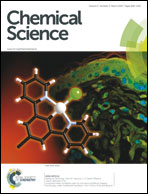Electronic and molecular structures of the active-site H-cluster in [FeFe]-hydrogenase determined by site-selective X-ray spectroscopy and quantum chemical calculations†
Abstract
The [FeFe]-hydrogenase (HydA1) from green algae is the minimal enzyme for efficient biological hydrogen (H2) production. Its active-site six-iron center (H-cluster) consists of a cubane, [4Fe4S]H, cysteine-linked to a diiron site, [2Fe]H. We utilized the spin-polarization of the iron Kβ X-ray fluorescence emission to perform site-selective X-ray absorption experiments for spectral discrimination of the two sub-complexes. For the H-cluster in reduced HydA1 protein, XANES and EXAFS spectra, Kβ emission lines (3p → 1s transitions), and core-to-valence (pre-edge) absorption (1s → 3d) and valence-to-core (Kβ2,5) emission (3d → 1s) spectra were obtained, individually for [4Fe4S]H and [2Fe]H. Iron–ligand bond lengths and intermetal distances in [2Fe]H and [4Fe4S]H were resolved, as well as fine structure in the high-spin iron containing cubane. Density functional theory calculations reproduced the X-ray spectral features and assigned the molecular orbital configurations, emphasizing the asymmetric d-level degeneracy of the proximal (Fep) and distal (Fed) low-spin irons in [2Fe]H in the non-paramagnetic state. This yielded a specific model structure of the H-cluster with a bridging carbon monoxide ligand and an apical open coordination site at Fed in [2Fe]H. The small HOMO–LUMO gap (∼0.3 eV) enables oxidation and reduction of the active site at similar potentials for reversible H2 turnover by HydA1, the LUMO spread over [4Fe4S]H supports its role as an electron transfer relay, and Fed carrying the HOMO is prepared for transient hydride binding. These features and the accessibility of Fed from the bulk phase can account for regio-specific redox transitions as well as H2-formation and O2-inhibition at the H-cluster. We provide a conceptual and experimental framework for site-selective studies on catalytic mechanisms in inhomogeneous materials.
![Graphical abstract: Electronic and molecular structures of the active-site H-cluster in [FeFe]-hydrogenase determined by site-selective X-ray spectroscopy and quantum chemical calculations](/en/Image/Get?imageInfo.ImageType=GA&imageInfo.ImageIdentifier.ManuscriptID=C3SC52703D&imageInfo.ImageIdentifier.Year=2014)

 Please wait while we load your content...
Please wait while we load your content...